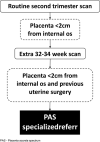Placenta Accreta Spectrum Disorders and Cesarean Scar Pregnancy Screening: Are we Asking the Right Questions?
- PMID: 34182579
- PMCID: PMC10304747
- DOI: 10.1055/s-0041-1731301
Placenta Accreta Spectrum Disorders and Cesarean Scar Pregnancy Screening: Are we Asking the Right Questions?
Conflict of interest statement
The authors have no conflict of interests to declare.
Figures


Similar articles
-
Cesarean Scar Pregnancy: Diagnosis and Pathogenesis.Obstet Gynecol Clin North Am. 2019 Dec;46(4):797-811. doi: 10.1016/j.ogc.2019.07.009. Obstet Gynecol Clin North Am. 2019. PMID: 31677755 Review.
-
Unforeseen consequences of the increasing rate of cesarean deliveries: early placenta accreta and cesarean scar pregnancy. A review.Am J Obstet Gynecol. 2012 Jul;207(1):14-29. doi: 10.1016/j.ajog.2012.03.007. Epub 2012 Mar 10. Am J Obstet Gynecol. 2012. PMID: 22516620 Review.
-
Placenta Accreta Overlying a Caesarean Section Scar: A 10-Year Experience in a Tertiary-Care Centre in Portugal.Acta Med Port. 2021 Mar 31;34(4):266-271. doi: 10.20344/amp.14001. Epub 2021 Apr 1. Acta Med Port. 2021. PMID: 34214418
-
Cesarean Scar Pregnancy Complicated with Placenta Percreta.Med Arch. 2019 Feb;73(1):58-60. doi: 10.5455/medarh.2019.73.58-60. Med Arch. 2019. PMID: 31097863 Free PMC article.
-
[Effect of placenta previa attached to cesarean scar for adverse pregnant outcomes in patients with placenta accreta spectrum disorders].Zhonghua Fu Chan Ke Za Zhi. 2021 Dec 25;56(12):861-867. doi: 10.3760/cma.j.cn112141-20210822-00458. Zhonghua Fu Chan Ke Za Zhi. 2021. PMID: 34954965 Chinese.
Cited by
-
Rectangular-Shaped Hemostatic Sutures in the Management of Second-Trimester Placenta Accreta Spectrum Disorders at Tu Du Hospital, Vietnam: A Retrospective Descriptive Study.AJP Rep. 2025 Jun 10;15(2):e79-e88. doi: 10.1055/a-2608-0990. eCollection 2025 Apr. AJP Rep. 2025. PMID: 40503449 Free PMC article.
-
Placenta Accreta Spectrum Disorders: Current Recommendations from the Perspective of Antenatal Imaging.Rev Bras Ginecol Obstet. 2023 Jun;45(6):297-302. doi: 10.1055/s-0043-1770917. Epub 2023 Jul 21. Rev Bras Ginecol Obstet. 2023. PMID: 37494571 Free PMC article. No abstract available.
-
Placenta Accreta Spectrum Prenatal Diagnosis Performance: Are Ultrasound False-positive Results Acceptable in Limited-resources Settings?Rev Bras Ginecol Obstet. 2022 Sep;44(9):838-844. doi: 10.1055/s-0042-1751061. Epub 2022 Sep 6. Rev Bras Ginecol Obstet. 2022. PMID: 36067797 Free PMC article.
References
-
- Trends in maternal mortality 2000 to 2017: estimates by WHO, UNICEF, UNFPA, World Bank Group and the United Nations Population Division [Internet] Geneva: World Health Organization; 2019[cited 2020 Dec 15]. Available from:https://www.who.int/reproductivehealth/publications/maternal-mortality-2...
MeSH terms
LinkOut - more resources
Full Text Sources
Medical
